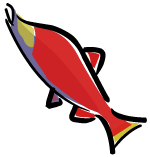
All Alaska Salmon are wild…They’re never penned in…never cooped up…They live as they have since the ice age…And are caught in ways that date back decades or even centuries.
Alaska’s marine habitats are extremely clean, and Alaska’s seafood is pure and remarkably free of contamination by pesticides, petroleum derivatives, PCBs, metals, and bacteria. Alaska’s human population density is lower than most places in the world and thousands of miles away from large sources of pollution. These distances, combined with the earth’s patterns of circulation of water and air, help to ensure that Alaska’s own waters are among the cleanest in the world.
Alaska has little heavy industry, and strict regulations governing development activities, such as road building, mining, logging, and sewage treatment. In addition, the State of Alaska Department of Environmental Conservation (ADEC) requires prior approval for any in-stream construction activities in Alaska’s salmon streams. The Forest Practices Act requires buffer zones from logging along salmon streams to prevent erosion and protect spawning and rearing habitat. Clean marine habitats produce pure seafood products.
Pacific salmon finds its spawning ground in the long rivers of Alaska and grows to maturity in the cold waters of the north Pacific Ocean. The salmon returns to the fresh water where they were born to set the stage for a new generation.
With a combination of a natural habitat and very limited impact from industrialization or intense tourism, the Alaska waters are home to five main species of salmon. The different salmon species that cruise the waters around Alaska are:
- King (Chinook)
- Sockeye (Red)
- Coho (Silver)
- Pink (Humpback)
- Keta (Chum)
HARVESTING METHODS
The season coincides with the return of salmon to their spawning streams – but before fishing is opened, state biologists make sure ample numbers have already passed upstream to lay eggs. When the quota for a particular run has moved past the tower, word goes out by radio to boats waiting beyond the river mouth. Fishing is open for the next few hours. By being smart about how they fish, the fishermen, families and Alaska natives who depend on salmon know this wild natural resource will be available for generations to come.
BY HAND: Trollers work offshore to catch salmon each year before they move to their spawning rivers. The crew, typically just a person or two, baits hooks or lures to each line before fanning them out behind the boat. When salmon are caught, each is brought in by hand. It’s a slow, time-consuming process.
SEINING: Purse seining is done from larger boats. A circular net, or purse seine, is set around a school of migrating salmon, typically Keta and Pink. The net is then drawn closed at the bottom, like a huge string bag, capturing the fish. Because salmon migrate in such tight schools, an Alaskan seiner can catch anywhere from 250 to more than 1,500 salmon with a single net.
GILLNETTING: Gillnetting comes into play as Coho, Keta and Sockeye Salmon leave the ocean behind and make their way to the river mouth. A net is set to intercept the incoming schools. Salmon swim part way through the mesh and become entangled. The net is then hauled onboard or ashore, where the salmon are harvested. Boats upload their catch to a tender vessel for transfer to shore. The use of brailer bags reduces handling and helps ensure a high-quality product.
Source: Alaska Seafood Marketing Institute
Pacific salmon finds its spawning ground in the long rivers of Alaska and grows to maturity in the cold waters of the north Pacific Ocean. The salmon returns to the fresh water where they were born to set the stage for a new generation.
With a combination of a natural habitat and very limited impact from industrialization or intense tourism, the Alaska waters are home to five main species of salmon. The different salmon species that cruise the waters around Alaska are:
- King (Chinook)
- Sockeye (Red)
- Coho (Silver)
- Pink (Humpback)
- Keta (Chum)
The superior flavor of Alaska salmon depends upon fat content and the environment in which it matured. Alaska’s icy, pure waters and the abundance of natural food give Alaska salmon unparalleled flavor. The fat content of salmon depends not only on the genetic make-up of each species, but also on its spawning cycle. The longer and more vigorous the freshwater trip, the more of the healthy Omega 3 oils the fish will carry as it leaves the ocean.
Try it out! Order here:
Order form
Check out delicious salmon recipes here: http://recipes.alaskaseafood.org/




